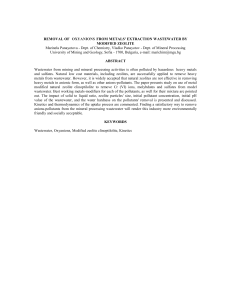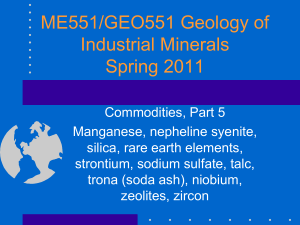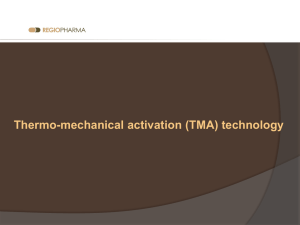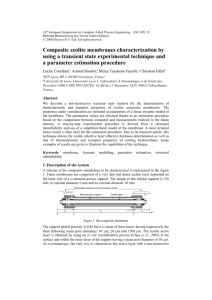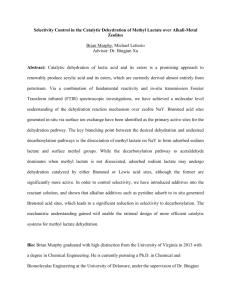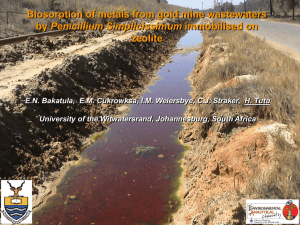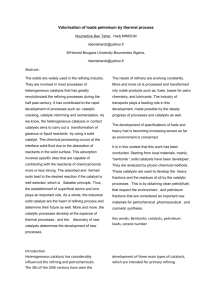Introduction: "La Roca Magica" - United States Antimony Corporation
advertisement
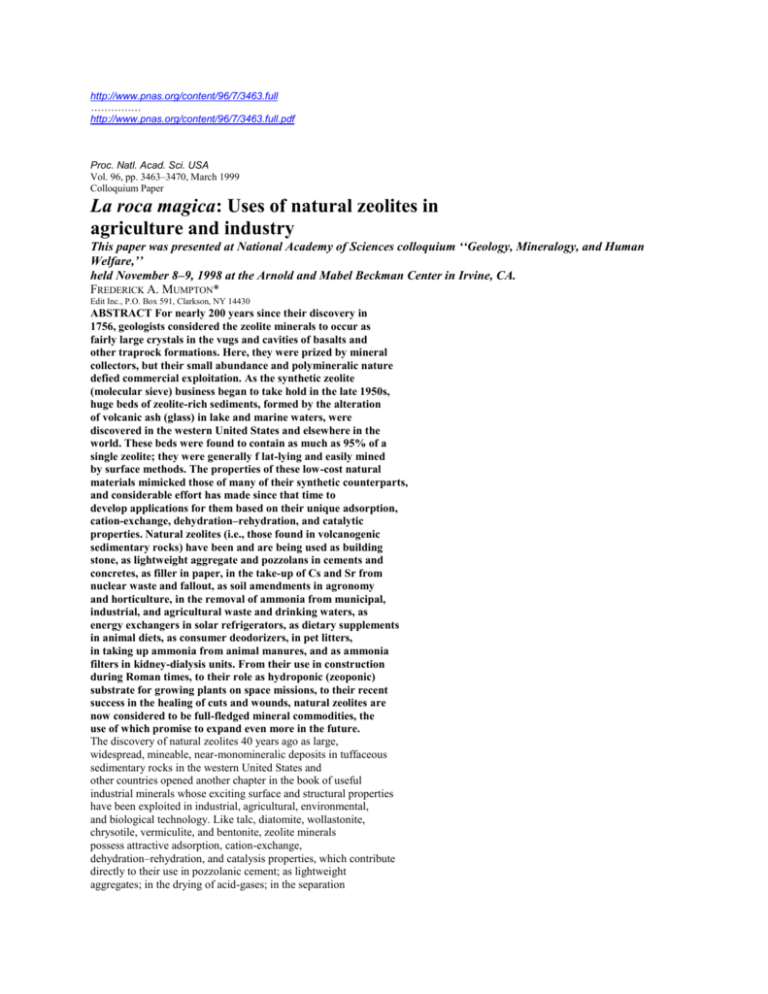
http://www.pnas.org/content/96/7/3463.full
……………
http://www.pnas.org/content/96/7/3463.full.pdf
Proc. Natl. Acad. Sci. USA
Vol. 96, pp. 3463–3470, March 1999
Colloquium Paper
La roca magica: Uses of natural zeolites in
agriculture and industry
This paper was presented at National Academy of Sciences colloquium ‘‘Geology, Mineralogy, and Human
Welfare,’’
held November 8–9, 1998 at the Arnold and Mabel Beckman Center in Irvine, CA.
FREDERICK A. MUMPTON*
Edit Inc., P.O. Box 591, Clarkson, NY 14430
ABSTRACT For nearly 200 years since their discovery in
1756, geologists considered the zeolite minerals to occur as
fairly large crystals in the vugs and cavities of basalts and
other traprock formations. Here, they were prized by mineral
collectors, but their small abundance and polymineralic nature
defied commercial exploitation. As the synthetic zeolite
(molecular sieve) business began to take hold in the late 1950s,
huge beds of zeolite-rich sediments, formed by the alteration
of volcanic ash (glass) in lake and marine waters, were
discovered in the western United States and elsewhere in the
world. These beds were found to contain as much as 95% of a
single zeolite; they were generally f lat-lying and easily mined
by surface methods. The properties of these low-cost natural
materials mimicked those of many of their synthetic counterparts,
and considerable effort has made since that time to
develop applications for them based on their unique adsorption,
cation-exchange, dehydration–rehydration, and catalytic
properties. Natural zeolites (i.e., those found in volcanogenic
sedimentary rocks) have been and are being used as building
stone, as lightweight aggregate and pozzolans in cements and
concretes, as filler in paper, in the take-up of Cs and Sr from
nuclear waste and fallout, as soil amendments in agronomy
and horticulture, in the removal of ammonia from municipal,
industrial, and agricultural waste and drinking waters, as
energy exchangers in solar refrigerators, as dietary supplements
in animal diets, as consumer deodorizers, in pet litters,
in taking up ammonia from animal manures, and as ammonia
filters in kidney-dialysis units. From their use in construction
during Roman times, to their role as hydroponic (zeoponic)
substrate for growing plants on space missions, to their recent
success in the healing of cuts and wounds, natural zeolites are
now considered to be full-fledged mineral commodities, the
use of which promise to expand even more in the future.
The discovery of natural zeolites 40 years ago as large,
widespread, mineable, near-monomineralic deposits in tuffaceous
sedimentary rocks in the western United States and
other countries opened another chapter in the book of useful
industrial minerals whose exciting surface and structural properties
have been exploited in industrial, agricultural, environmental,
and biological technology. Like talc, diatomite, wollastonite,
chrysotile, vermiculite, and bentonite, zeolite minerals
possess attractive adsorption, cation-exchange,
dehydration–rehydration, and catalysis properties, which contribute
directly to their use in pozzolanic cement; as lightweight
aggregates; in the drying of acid-gases; in the separation
of oxygen from air; in the removal of NH3 from drinking water
and municipal wastewater; in the extraction of Cs and Sr from
nuclear wastes and the mitigation of radioactive fallout; as
dietary supplements to improve animal production; as soil
amendments to improve cation-exchange capacities (CEC)
and water sorption capacities; as soilless zeoponic substrate for
greenhouses and space missions; in the deodorization of
animal litter, barns, ash trays, refrigerators, and athletic footwear;
in the removal of ammoniacal nitrogen from saline
hemodialysis solutions; and as bactericides, insecticides, and
antacids for people and animals. This multitude of uses of
natural zeolites has prompted newspapers in Cuba, where large
deposits have been discovered, to refer to zeolites as the magic
rock, hence the title of this paper.
The present paper reviews the critical properties of natural
zeolites and important uses in pollution control, the handling
and storage of nuclear wastes, agriculture, and biotechnology.
The paper also pleads for greater involvement by mineral
scientists in the surface, colloidal, and biochemical investigations
that are needed in the future development of zeolite
applications.
PROPERTIES
A zeolite is a crystalline, hydrated aluminosilicate of alkali and
alkaline earth cations having an infinite, open, threedimensional
structure. It is further able to lose and gain water
reversibly and to exchange extraframework cations, both without
change of crystal structure. The large structural cavities
and the entry channels leading into them contain water
molecules, which formhydration spheres around exchangeable
cations. On removal of water by heating at 350–400°C, small
molecules can pass through entry channels, but larger molecules
are excluded—the so called ‘‘molecular sieve’’ property
of crystalline zeolites. The uniform size and shape of the rings
of oxygen in zeolites contrasts with the relatively wide range of
pore sizes in silica gel, activated alumina, and activated carbon,
and the Langmuir shape of their adsorption isotherms allows
zeolites to remove the last trace of a particular gas from a
system (e.g.,H2Ofrom refrigerator Freon lines). Furthermore,
zeolites adsorb polar molecules with high selectivity. Thus,
polar CO2 is adsorbed preferentially by certain zeolites, allowing
impure methane or natural gas streams to be upgraded.
The quadrupole moment of N2 contributes to its selective
adsorption by zeolites from air, thereby producingO2-enriched
products. The adsorption selectivity for H2O, however, is
greater than for any other molecule, leading to uses in drying
and solar heating and cooling.
The weakly bonded extraframework cations can be removed
or exchanged readily by washing with a strong solution of
another cation. The CEC of a zeolite is basically a function of
the amount of Al that substitutes for Si in the framework
tetrahedra; the greater the Al content, the more extraframework
cations needed to balance the charge. Natural zeolites
have CECs from 2 to 4 milliequivalentsyg (meqyg), about twice
the CEC of bentonite clay. Unlike most noncrystalline ion
PNAS is available online at www.pnas.org.
Abbreviations: CEC, cation-exchange capacity; meq, milliequivalent.
*To whom reprint requests should be addressed. e-mail: fmumpton@
frontiernet.net.
3463
exchangers, e.g., organic resins and inorganic aluminosilicate
gels (mislabeled in the trade as ‘‘zeolites’’), the framework of
a crystalline zeolite dictates its selectivity toward competing
ions. The hydration spheres of high field-strength cations
prevent their close approach to the seat of charge in the
framework; hence, cations of low field strength are generally
more tightly held and selectively exchanged by the zeolite than
other ions. Clinoptilolite has a relatively small CEC ('2.25
meqyg), but its cation selectivity is
Cs . Rb . K . NH4 . Ba . Sr . Na . Ca . Fe . Al . Mg . Li.
This preference for larger cations, including NH4
1, was exploited
for removing NH4-N from municipal sewage effluent
and has been extended to agricultural and aquacultural applications
(1, 2). Clinoptilolite and natural chabazite have also
been used to extract Cs and Sr from nuclear wastes and fallout.
Most zeolites in volcanogenic sedimentary rocks were
formed by the dissolution of volcanic glass (ash) and later
precipitation of micrometer-size crystals, which mimic the
shape and morphology of their basalt counterparts (Fig. 1; ref.
3). Sedimentary zeolitic tuffs are generally soft, friable, and
lightweight and commonly contain 50–95% of a single zeolite;
however, several zeolites may coexist, along with unreacted
volcanic glass, quartz, K-feldspar, montmorillonite, calcite,
gypsum, and cristobaliteytridymite. Applications of natural
zeolites make use of one or more of the following properties:
(i) cation exchange, (ii) adsorption and related molecularsieving,
(iii) catalytic, (iv) dehydration and rehydration, and (v)
biological reactivity. Extrinsic properties of the rock (e.g.,
siliceous composition, color, porosity, attrition resistance, and
bulk density) are also important in many applications. Thus,
the ideal zeolitic tuff for both cation-exchange and adsorption
applications should be mechanically strong to resist abrasion
and disintegration, highly porous to allow solutions and gases
to diffuse readily in and out of the rock, and soft enough to be
easily crushed. Obviously, the greater the content of a desired
zeolite, the better a certain tuff will perform, ceteris paribus.
(See Table 1 for more information on the properties of
zeolites.)
APPLICATIONS
Construction
Dimension Stone. Devitrified volcanic ash and altered tuff
have been used for 2,000 years as lightweight dimension stone.
Only since the 1950s, however, has their zeolitic nature been
recognized. Their low bulk density, high porosity, and homogeneous,
close-knit texture have contributed to their being
easily sawed or cut into inexpensive building blocks. For
example, many Zapotec buildings near Oaxaca, Mexico, were
constructed of blocks of massive, clinoptilolite tuff (4), which
is still used for public buildings in the region. The easily cut and
fabricated chabazite- and phillipsite-rich tuffo giallo napolitano
in central Italy has also been used since Roman times in
construction, and the entire city of Naples seems to be built out
of it (Fig. 2). Numerous cathedrals and public buildings in
central Europe were built from zeolitic tuff quarried in the
Laacher See area of Germany. Early ranch houses (Fig. 3) in
the American West were built with blocks of locally quarried
erionite; they were cool and did not crumble in the arid
climate. Similar structures made of zeolitic tuff blocks have
been noted near almost every zeolitic tuff deposit in Europe
and Japan (5).
Cement and Concrete. The most important pozzolanic raw
material used by the ancient Romans was obtained from the
tuffo napolitano giallo near Pozzuoli, Italy (6, 7). Similar
FIG. 1. Scanning electron micrograph of plates of clinoptilolite
from Castle Creek, ID [Reproduced with permission from ref. 3
(Copyright 1976, The Clay Minerals Society)].
Table 1. Representative formulae and selected physical properties of important zeolites*
Zeolite
Representative unit-cell
formula
Void volume,
%
Channel dimensions,
Å
Thermal stability
(relative) CEC, meq/g†
Analcime Na10(Al16Si32O96)z16H2O 18 2.6 High 4.54
Chabazite (Na2Ca)6(Al12Si24O72)z40H2O 47 3.7 3 4.2 High 3.84
Clinoptilolite (Na3K3)(Al6Si30O72)z24H2O 34 3.9 3 5.4 High 2.16
Erionite (NaCa0.5K)9(Al9Si27O72)z27H2O 35 3.6 3 5.2 High 3.12
Faujasite (Na58)(Al58Si134O384)z240H2O 47 7.4 High 3.39
Ferrierite (Na2Mg2)(Al6Si30O72)z18H2O 28 4.3 3 5.5 High 2.33
Heulandite (Ca4)(Al8Si28O72)z24H2O 39 4.0 3 5.5 Low 2.91
4.4 3 7.2
4.1 3 4.7
Laumonitte (Ca4)(Al8Si16O48)z16H2O 34 4.6 3 6.3 Low 4.25
Mordenite (Na8)(Al8Si40O96)z24H2O 28 2.9 3 5.7 High 2.29
6.7 3 7.0
Phillipsite (NaK)5(Al5Si11O32)z20H2O 31 4.2 3 4.4 Medium 3.31
2.8 3 4.8
3.3
Linde A (Na12)(Al12Si12O48)z27H2O 47 4.2 High 5.48
Linde X (Na86)(Al86Si106O384)z264H2O 50 7.4 High 4.73
*Modified from refs. 103 and 104. Void volume determined from water content.
†Calculated from unit-cell formula.
3464 Colloquium Paper: Mumpton Proc. Natl. Acad. Sci. USA 96 (1999)
materials have been used in cement production throughout
Europe. The high silica content of the zeolites neutralizes
excess lime produced by setting concrete, much like finely
powdered pumice or fly ash. In the U.S., nearly $1 million was
saved in 1912 during the construction of the 240-mile-long Los
Angeles aqueduct by replacing #25% of the required portland
cement with an inexpensive clinoptilolite-rich tuff mined near
Tehachapi, CA (8, 9).
Lightweight Aggregate. Much like perlite and other volcanic
glasses are frothed into low-density pellets for use as lightweight
aggregate in concrete, zeolitic tuff can be ‘‘popped’’ by
calcining at elevated temperature. Clinoptilolite from Slovenia
and Serbia yields excellent aggregates of this type on firing to
1,200–1,400°C. Densities of $0.8 gycm3 and porosities of
#65% have been reported for expanded clinoptilolite products
(10). These temperatures are somewhat higher than those
needed to expand perlite, but the products are stronger (11).
The Russian Sibeerfoam product is expanded zeolitic tuff and
is used as lightweight insulating material (12). In Cuba,
mortars for ferrocement boats and lightweight aggregate for
hollow prestressed concrete slabs contain indigenous clinoptilolite
(13, 14). The mortars have compressive strengths of
#55.0 MPa; the ferrocement boats can withstand marine
environments.
Water and Wastewater Treatment
Municipal Wastewater. Large-scale cation-exchange processes
using natural zeolites were first developed by Ames (1)
and Mercer et al. (2), who demonstrated the effectiveness of
clinoptilolite for extracting NH4
1 from municipal and agricultural
waste streams. The clinoptilolite exchange process at the
Tahoe–Truckee (Truckee, CA) sewage treatment plant removes
.97% of the NH4
1 from tertiary effluent (15). Hundreds
of papers have dealt with wastewater treatment by
natural zeolites. Adding powdered clinoptilolite to sewage
before aeration increased O2-consumption and sedimentation,
resulting in a sludge that can be more easily dewatered and,
hence, used as a fertilizer (16). Nitrification of sludge is
accelerated by the use of clinoptilolite, which selectively
exchanges NH4
1 from wastewater and provides an ideal
growth medium for nitrifying bacteria, which then oxidize
NH4
1 to nitrate (17–19). Liberti et al. (19) described a
nutrient-removal process called RIM-NUT that uses the selective
exchange by clinoptilolite and an organic resin to
remove N2 and P from sewage effluent.
Drinking Water. In the late 1970s, a 1-MGD (million gallons
per day) water-reuse process that used clinoptilolite cationexchange
columns went on stream in Denver, CO, (Fig. 4) and
brought the NH4
1 content of sewage effluent down to potable
standards (,1 ppm; refs. 20–22). Based on Sims and coworkers’
(23, 24) earlier finding that nitrification of sewage sludge
was enhanced by the presence of clinoptilolite, a clinoptiloliteamended
slow-sand filtration process for drinking water for the
city of Logan, UT, was evaluated. By adding a layer of crushed
zeolite, the filtration rate tripled, with no deleterious effects.
At Buki Island, upstream from Budapest, clinoptilolite filtration
reduced the NH3 content of drinking water from 15–22
ppm to ,2 ppm (25, 26). Clinoptilolite beds are used regularly
to upgrade river water to potable standards at Ryazan and
other localities in Russia and at Uzhgorod, Ukraine (27, 28).
FIG. 2. Castel Nuovo (Naples, Italy) constructed of tuffo giallo
napolitano [Reproduced with permission from ref. 105 (Copyright
1995, International Committee on Natural Zeolites)].
FIG. 3. Abandoned ranch house in Jersey Valley, NV, constructed
of quarried blocks of erionite-rich tuff [Reproduced with permission
from ref. 5 (Copyright 1973, Industrial Minerals)].
FIG. 4. Clinoptilolite-filled columns at a Denver, CO, waterpurification
plant [Reproduced with permission from ref. 106 (Copyright
1997, AIMAT)].
FIG. 5. Methane-purification pressure-swing adsorption unit,
NRG Company, Palos Verde Landfill, Los Angeles, CA [Reproduced
with permission from ref. 106 (Copyright 1997, AIMAT)].
Colloquium Paper: Mumpton Proc. Natl. Acad. Sci. USA 96 (1999) 3465
The selectivity of several natural zeolites for Pb21 suggests an
inexpensive means of removing lead from drinking water.
Adsorption and Catalysis
Two principal uses of synthetic molecular sieves are the
purification of gaseous hydrocarbons and the preparation of
catalysts for petroleum refining. In general, natural zeolites do
not compete with their synthetic counterparts in adsorption or
catalytic applications because of their inherent lower adsorption
capacities and, to some extent, to the presence of traces of
Fe and other catalyst ‘‘poisons.’’ Most natural materials have
smaller pore openings than the synthetics. Despite the low cost
of the natural materials (a few cents per kilogram), the
economics of hardware construction, activation, and regeneration
favor the more expensive synthetics, even at $2.00ykg, for
most adsorption applications.
By using certain natural zeolites, however, researchers have
made headway in the drying and purification of acid gases.
Mordenite and chabazite, for example, can withstand the
rigors of continuous cycling in acid environments and have
been used to remove water and carbon dioxide from sour
natural gas. Union Carbide Corporation (now UOP Corporation,
Tarrytown, NY) marketed an AW-500 product (natural
chabazite-rich tuff from Bowie, AZ) for removing HCl from
reformed H2 streams (pH , 2), H2O from Cl2, and CO2 from
stack gas emissions (29). NRG Corporation (Los Angeles, CA;
ref. 30) used a pressure-swing adsorption process with Bowie
chabazite to remove polar H2O, H2S, and CO2 from low-BTU
(British thermal unit) natural gas and developed a zeoliteadsorption
process for purifying methane produced by decaying
garbage in a Los Angeles landfill (Fig. 5). A pressure-swing
adsorption process using natural mordenite was developed in
Japan to produce high-grade O2 from air (T. Tamura, unpublished
work; refs. 31 and 32). Domine´ and Ha¨y (33) showed
that the quadrupole moment of nitrogen is apparently responsible
for its adsorption by a dehydrated zeolite in preference to
oxygen, resulting in a distinct separation of the two gases for
a finite length of time. Similar processes use synthetic CaA
zeolite to produce O2 in sewage-treatment plants in several
countries. In Japan, small zeolite adsorption units generate
O2-enriched air for hospitals, in fish breeding and transportation,
and in poorly ventilated restaurants.
Modifying the surface of clinoptilolite with long-chain quaternary
amines allowed it to adsorb benzene, toluene, and
xylene in the presence of water, a process that shows promise
in the clean up of gasoline and other petroleum spills (34–36).
These hydrophilic products can be treated further with additional
amine to produce anion exchangers capable of taking up
chromate, arsenate, selenate, and other metal oxyanions from
aqueous solutions.
Applications in catalysis include (i) a selective-forming
catalyst developed by Mobil Corporation using natural erioniteclinoptilolite (37); (ii) a hydrocarbon conversion catalyst
for the disproportionation of toluene to benzene and xylene,
employing a hydrogen-exchanged natural mordenite (38); (iii)
a catalyst using cation-exchanged clinoptilolite from Tokaj,
Hungary, for the hydromethylation of toluene (39); and (iv)
clinoptilolite catalysts for the isomerization of n-butene, the
dehydration of methanol to dimethyl ether, and the hydration
of acetylene to acetaldehyde (40).
Nuclear Waste and Fallout
Nuclear Waste. Early experiments were aimed at concentrating
137Cs and 90Sr from low-level waste streams of nuclear
reactors and leaking repositories on clinoptilolite (41–43). The
‘‘saturated’’ zeolite was transformed into concrete, glass, or
ceramic bodies and stored indefinitely. Natural zeolites have
superior selectivity for certain radionuclides (e.g., 90Sr, 137Cs
60Co, 45Ca, and 51Cr) compared with organoresins and are
cheaper and much more resistant to nuclear degradation.
Dozens of papers have demonstrated the ability of several
natural zeolites to take up these and other radionuclides
(44–47). A mixture of synthetic zeolite A and natural chabazite
from Bowie, AZ, was used to take up Sr and Cs, respectively,
from contaminated waters at Three Mile Island, PA (48).
Clinoptilolite currently is used to remove Sr and Cs from
low-level effluents from a nuclear power plant before they are
released to the Irish Sea at Sellafield, U.K. (49), and to capture
these isotopes from leaking repository containers at West
Valley, NY (50).
Nuclear Fallout. The same selectivities for Cs and Sr by
zeolites permit treatment of radioactive fallout from nuclear
tests and accidents. The addition of clinoptilolite to soils
contaminated with 90Sr markedly reduced the strontium uptake
by plants (51), and the presence of clinoptilolite inhibited
the uptake of Cs in contaminated Bikini Atoll soils (52).
Several zeolite processes have been developed to counteract
the fallout from the 1986 Chernobyl disaster. Shenbar and
Johanson (53) found that 137Cs in soils was not taken up by
plants after treating the soil with a zeolite, and Forberg et al.
(54) showed that a zeolite supplement to the diets of Swedish
reindeer accelerated the excretion of 137Cs ingested with food
contaminated by Chernobyl fallout. Zeolites added to soils
reduced the uptake of 137Cs by pasture plants in the vicinity of
Chernobyl (55), and dietary zeolite reduced sorption of radiocesium
by sheep fed fallout-contaminated rations in Scotland
(56). In Bulgaria, zeolite pills and cookies were prepared
for human consumption to counteract Chernobyl fallout (57).
The zeolite apparently exchanges 137Cs and 90Sr in the gastrointestinal
tract and is excreted by normal processes, thereby
minimizing assimilation into the body.
Agriculture
Animal Nutrition and Health. Since 1965, studies in Japan
using #10% clinoptilolite and mordenite as dietary supplements
for swine and poultry showed that test animals generally
grew faster than control groups, with simultaneous decrease in
the amount and cost of the feed. Young and mature pigs fed
rations containing 5% clinoptilolite gained 16% more weight
than animals fed a normal diet (58, 59). The animals’ excrement
was less odoriferous because of the take up of NH4
1 by
the zeolite, and the number and severity of intestinal diseases
decreased. To reduce the toxic effect of high NH4
1 in ruminal
fluids when nonprotein-nitrogens, such as urea and biuret, are
added to animal diets, White and Ohlrogge (60) introduced
both synthetic and natural zeolites into the rumen of test
animals. NH4
1 formed by the enzyme decomposition of the
nonprotein-nitrogen was exchanged immediately by the zeolite
and held for several hours until released by Na1 entering the
rumen in saliva. This gradual release of the excess nitrogen
allowed rumen organisms to synthesize cellular protein for
assimilation into the animals’ digestive systems. Several hundred
studies of the effect of zeolites in animal diets have been
made in the U.S. and elsewhere (61). The results are mixed, but
in countries in which the level of animal productivity is not as
high as in the U.S. and the sanitary conditions of feed lots and
production facilities are much worse, substantial increases in
productivity and mortality have been achieved (62). Weight
gain may be caused by the zeolite acting as an ammonium
reservoir in the gastrointestinal tract, thereby allowing the
animal to use ingested nitrogen more efficiently. The prevention
or minimization of scours and other intestinal diseases,
however, is more baffling. An NH4
1-containing zeolite may
support the growth of nitrogen-loving bacteria that contribute
to the health of the animals; the zeolite may take up deleterious
heavy metals, or it may simply regulate pH in the gut
system, resulting in fewer or less severe stomach ailments.
3466 Colloquium Paper: Mumpton Proc. Natl. Acad. Sci. USA 96 (1999)
These reactions await serious physiological and biochemical
examination.
Natural zeolites and some clay minerals have proven to be
effective in protecting animals against mycotoxins (63, 64).
The apparent ability of clinoptilolite and other zeolites to
absorb aflatoxins that contaminate animal feeds has resulted
in measurable improvements in the health of swine, sheep, and
chickens (65–67). Here also, more work is needed to verify and
understand the mechanisms of such reactions.
Agronomy and Horticulture. Natural zeolites are used extensively
in Japan as amendments for sandy, clay-poor soils
(68). The pronounced selectivity of clinoptiloliteNH4
1 and K1
also was exploited in Japan in slow-release chemical fertilizers.
By using clinoptilolite-rich tuff as a soil conditioner, significant
increases in the yields of wheat (13–15%), eggplant (19–55%),
apples (13–38%), and carrots (63%) were reported when 4–8
tonneyacre zeolite was used (69). The addition of clinoptilolite
increased barley yields (70); it also increased the yields of
potatoes, barley, clover, and wheat after adding 15 tonney
hectare to Ukrainian sandy loams (71). Clinoptilolite amended
to a potting medium for chrysanthemums behaved like a
slow-release K-fertilizer, yielding the same growth for the
plants as daily irrigation with Hoagland’s solution (72). The
addition of NH4
1-exchanged clinoptilolite in greenhouse experiments
resulted in 59% and 53% increase in root weight of
radishes in medium- and light-clay soils, respectively (73). A
10% addition of clinoptilolite to sand used in the construction
of golf-course greens substantially reduced NO3-leaching and
increased fertilizer-N uptake by creeping bent-grass, without
disturbing the drainage, compaction, or ‘‘playability’’ of the
greens (74–76).
In Italy, natural zeolites have been used as dusting agents to
kill aphids afflicting fruit trees (J. L. Gonzalez, personal
communication). The mechanism of this reaction is not
known; the zeolite could be acting as a desiccant, although it
is saturated almost completely with water before use, or its
highly alkaline character in water could simply kill individual
insects that come in contact with it.
The use of clinoptilolite as the principal constituent of
artificial soil was developed in Bulgaria in the late 1970s. The
growth of plants in synthetic soils consisting of zeolites with or
without peat, vermiculite, and the like has been termed
zeoponics. A nutrient-treated zeoponic substrate used for
growing crops and the rooting of cuttings in greenhouses
produced greater development of root systems and larger
yields of strawberries, tomatoes, and peppers, without further
fertilization (77). Tomatoes and cucumbers are grown commercially
outdoors in Cuba (Fig. 6) by using zeoponic substrate
(78), and vegetables currently are supplied to Moscow in the
winter from greenhouses that use zeoponic synthetic soils. By
using a treated Bulgarian clinoptilolite product, cabbage and
radishes have been grown aboard the Russian space station
Mir (79). Considerable attention has been paid to zeoponic
mixtures of NH4- or K-exchanged natural zeolites and sparFIG. 6. Tomatoes grown zeoponically in Havana, Cuba [Reproduced with permission from ref. 106 (Copyright 1997, AIMAT)].
FIG. 7. Wheat grown zeoponically for use in space flights and stations, Johnson Space Center, Houston, TX [Reproduced with permission from
ref. 106 (Copyright 1997, AIMAT)]. Photograph by D. W. Ming.
Colloquium Paper: Mumpton Proc. Natl. Acad. Sci. USA 96 (1999) 3467
ingly soluble phosphate minerals (e.g., apatite; refs. 80 and 81).
The small amount of Ca in the soil solution in equilibrium with
the apatite exchanges onto the zeolite, thereby disturbing the
equilibrium and forcing more Ca into solution. The apatite is
ultimately destroyed, releasing P to the solution, and the
zeolite gives up its exchanged cations (e.g., K1 or NH4
1).
Taking the zeolite–apatite reaction one step further, the
National Aeronautics and Space Administration prepared a
substrate consisting of a specially cation-exchanged clinoptilolite
and a synthetic apatite containing essential trace nutrients
for use as a plant-growth medium in Shuttle flights (Fig. 7).
This formulation may well be the preferred substrate for
vegetable production aboard all future space missions (82) and
in commercial green houses.
Aquaculture. Natural zeolites can play three roles in aquaculture:
(i) to remove ammonium from hatchery, transport,
and aquarium waters; (ii) to generate oxygen for aeration
systems in aquaria and transport; and (iii) to supplement fish
rations. Zeolite cation exchange removes NH4
1 from recirculating
hatchery waters produced by the decomposition of
excrement andyor unused food, much as NH4
1 is removed
from municipal sewage effluent (83–85). Phillipsite from the
Neapolitan Yellow Tuff was used to remove NH4
1 from the
effluent from saline water in shrimp-culture tanks (86). Although
zeolites are not as successful with saline-water as they
are with freshwater effluents, these results suggest limited
applications in seawater systems. The NH3 content of tanktruck
waters was reduced by such a system during the transport
of live fish (87–89), and Jungle Laboratories (Comfort, TX)
developed a technique of adding natural zeolites to plastic bags
containing tropical fish to take up NH3 generated during
transport. In the U.S., at least four brands of granular clinoptilolite
are currently on the market for use in filters in home
aquaria, and fist-size blocks of zeolitic tuff have been sold as
decorative (and ammonium-removing) additions to hobbyists’
fish tanks.
The physiological similarity of fish and poultry suggests that
the results achieved by feeding natural zeolites to chickens
might be duplicated in fish at a considerable savings in cost.
Several authors have reported that small additions of clinoptilolite
(2%) in the rations of trout resulted in #10% improvement
in biomass production, with no apparent ill effects
on the fish (90–92).
Animal-Waste Treatment. Natural zeolites are potentially
capable of (i) reducing the malodor and increasing the nitrogen
retentivity of animal wastes, (ii) controlling the moisture
content for ease of handling of excrement, and (iii) purifying
the methane gas produced by the anaerobic digestion of
manure. Several hundred tonnes of clinoptilolite is used each
year in Japanese chicken houses; it is either mixed with the
droppings or packed in boxes suspended from the ceilings (K.
Torii, unpublished work).Azeolite-filled air scrubber was used
to improve poultry-house environments by extracting NH3
from the air without the loss of heat that accompanies
ventilation in colder weather (93). Granular clinoptilolite
added to a cattle feedlot (2.44 kgym2) significantly reduced
NH3 evolution and odor compared with untreated areas (94).
As more and more animals and poultry are raised close to the
markets to reduce transportation costs, the need to decrease
FIG. 8. Zeolite deodorization products from Itaya, Japan [Reproduced with permission from ref. 106 (Copyright 1997, AIMAT)].
FIG. 9. Footwear and garbage-can zeolite deodorization products [Reproduced with permission from ref. 106 (Copyright 1997, AIMAT)].
3468 Colloquium Paper: Mumpton Proc. Natl. Acad. Sci. USA 96 (1999)
air pollution in areas of large population becomes ever more
apparent.
Other Applications
Consumer Products. Numerous natural zeolite-containing
consumer products have come on the market in the U.S.,
Japan, Hungary, Cuba, and Germany, chiefly as deodorizing
agents and as pet litters to take up water and odor-causingNH3
from animal urine (Fig. 8). A horse-stall refreshener consisting
solely of crushed clinoptilolite also has been sold in the U.S.,
and similar materials have been used for years at major
livestock shows to decrease odors in barns and stalls. These
applications depend mainly on the ability of clinoptilolite to
exchange NH4
1 from aqueous solution, thereby preventing the
release of NH3 into the atmosphere. Other natural zeolite
deodorization products have been marketed to remove malodors
from shoes, boots, and athletic footwear (e.g., Stinky
Pinkys and Odor Zappers) and from garbage cans, refrigerators,
and walk-in coolers (ref. 95 and 96; Fig. 9). The mechanism
by which these products have achieved success is not well
understood, but it is probably a surface-adsorption phenomena
on the zeolite. In Russia, an unusual product (Zeo-Light) has
been developed, consisting of zeolite-filled pillows and pads
for funeral caskets to eliminate malodors.
Medical Applications. Natural phillipsite and certain synthetic
zeolites were found to be effective filter media to remove
NH4
1 from the dialysate of kidney patients during hemodialysis,
thereby allowing the cleansed saline solution to be used
repeatedly in recirculating home and portable dialysis systems
(97, 98). Zeolites, especially the natural varieties, are substantially
less expensive than the zirconium phosphate ion exchanger
currently used. In Cuba, inexpensive, indigenous
natural zeolites are being studied as buffers to reduce stomach
acidity and to treat stomach ulcers (99). External application
of zeolite powder has been found to be effective in the
treatment of athlete’s foot (100) and to decrease the healing
time of wounds and surgical incisions (101, 102). Although no
systematic study has been made, anecdotal information from
three mining operations in the United States indicates that the
cuts and scrapes of mine and mill workers exposed to on-thejob
zeolite dust heal remarkably quickly. In Cuba, it is common
practice to dust the cuts of horses and cows with clinoptilolite
to hasten the healing process. The bactericidal reactivity of
natural zeolites is an untouched field.
ROLE OF MINERAL SCIENTISTS
Mineral scientists have played leading roles in the development
of applications for natural zeolites, e.g., Ames (41) studied the
cation-exchange properties of clinoptilolite and its use in
treating municipal sewage and nuclear waste waters; Stojanovic
(10) and Bush (11) studied the expansion properties of
clinoptilolite; Filizova (57) developed zeolite pills and cookies
to counteract Chernobyl fallout; White and Ohlrogge (60)
developed rations for ruminants fed nonprotein-nitrogensupplemented
feeds; and U.S. Geological Survey (80) and
National Aeronautics and Space Administration (82) mineral
scientists used zeoponic substrate in space vehicles and greenhouse
soils.
Although they brought to the table a broad base of scientific
knowledge, most were less than expert in agriculture or animal
science or in surface chemistry, colloid chemistry, or biochemistry,
and they often had to prod or persuade agricultural,
chemical, biological, and engineering colleagues to apply their
expertise to these fascinating problems. In the future, mineral
scientists investigating the use of natural zeolites (or of any of
the industrial minerals mentioned above) must become more
proficient in surface chemistry, cation exchange, biological
reactivity, and colloid chemistry if they are to continue to
contribute to the development of zeolite applications. In turn,
the chemist, agronomist, animal scientist, biochemist, and
engineer must become more knowledgeable about the mineral
sciences. Multidisciplinary, cooperative efforts are essential if
we are to understand, for example, how a zeolite functions in
an animal’s gastrointestinal system, how a zeolite gives rise to
greater growth or healthier animals, the specific mechanism of
surface adsorption of amine-treated zeolites with other organics
in aqueous solution, or how untreated zeolites adsorb
offending odors from footwear and other enclosed spaces. The
adsorption, cation-exchange, dehydration, catalytic, and biotechnical
properties of zeolitic materials must therefore become
a major part of a mineral scientist’s portfolio if he or she
is to become a full partner in future investigations.
1. Ames, L. L., Jr. (1967) in Proceedings of the 13th Pacific Northwest
Industrial Waste Conference (Washington State Univ., Pullman,
WA), pp. 135–152.
2. Mercer, B. W., Ames, L. L., Jr., Touhill, C. J., Van Slyke, W. J. &
Dean, R. B. (1970) J. Water Pollut. Control Fed. 42, R95–R107.
3. Mumpton, F. A. & Ormsby, W. C. (1976) Clays Clay Miner. 24, 1–23.
4. Mumpton, F. A. (1973) Am. Miner. 68, 287–289.
5. Mumpton, F. A. (1973) Ind. Miner. (London) 73, 30–45.
6. Norin, E. (1955) Geol. Rundsch. 43, 526–534.
7. Sersale, R. (1958) Rend. Accad. Sci. Fis. Mat. Naples 25, 181–207.
8. Mielenz, R. C., Green, K. T. & Schlette, N. C. (1951) Econ. Geol. 46,
311–328.
9. Drury, F. W. (1954) Calif. Miner. Inf. Serv. 7(10), 1–6.
10. Stojanovic, D. (1972) Proc. Serbian Geol. Soc. for 1968–70, 9–20.
11. Bush, A. L. (1974) Minutes: 25th Annual Meeting (Perlite Institute,
Colorado Springs, CO), p. 534 (abstr.).
12. Belitsky, I. A., Gorbunov, A. V., Kazantseva, L. K. & Fursenko, B. A.
(1995) Russian Patent RU 2,033,982.
13. Gayoso Blanco, R. A., De Jongh Caula, E.&Gil Izquierdo, C. (1993)
in Zeolites ’91: Memoirs of the 3rd International Conference on the
Occurrence, Properties & Utilization of Natural Zeolites, Havana, 1991,
eds. Rodriguez Fuentes, G. & Andres Gonzales, J. (Int. Conf.
Center, Havana, Cuba), pp. 203–207.
14. Gayoso, R. & Gil, C. (1994) in Proceedings of the 5th International
Symposium on Ferrocement, eds. Nedwell, P. J. & Swamy, R. N.
(Spon, London), pp. 141–150.
15. Butterfield, O. R. & Borgerding, J. (1981) Tahoe–Truckee Sanitation
Agency Internal Report (Tahoe–Truckee Sanitation Agency, Truckee,
CA).
16. Kallo´, D. (1995) in Natural Zeolites ’93: Occurrence, Properties, Use,
eds. Ming, D. W. & Mumpton, F. A. (Int. Comm. Nat. Zeolites,
Brockport, NY), pp. 341–350.
17. Sims, R. C. (1972) Environ. Sci. Eng. Notes 9, 2–4.
18. Sims, R. C. & Little, L. W. (1973) Environ. Lett. 4, 27–34.
19. Liberti, L., Lopez, A., Amicarelli, V. & Boghetich, G. (1995) in
Natural Zeolites ’93: Occurrence, Properties, Use, eds. Ming, D. W. &
Mumpton, F. A. (Int. Comm. Nat. Zeolites, Brockport, NY), pp.
351–362.
20. CH2M-Hill (1975) Report for Board of Water Commissioners, Denver,
Colorado (Cavvalis, OR).
21. Heaton, R. (1972) Water Wastes Eng. June, 32–34.
22. Rothberg, M. R., Work, S. W. & Lauer, W. C. (1981) in Municipal
Wastewater for Agriculture, eds. D’itri, F. M., Aguirre Martinez, J. &
Athie Lambarri, R. R. (Academic, New York), pp. 87–102.
23. McNair, D. R., Sims, R. C. & Grenney, W. J. (1986) Proc. Annu.
Conf. Am. Water Works Assoc. (American Water Works Association,
New York).
24. McNair, D. R., Sims, R. C., Sorensen, D. L. & Hulbert, M. (1987)
J. Am. Water Works Assoc. 79(12), 74–81.
25. Hlavay, J. (1986) Hidrol. Kozl. 66, 348–355.
26. Hlavay, J., Inczedy, J., Fo¨ldi-Polyak, K. & Zimonyi, M. (1988) in
Occurrence, Properties & Utilization of Natural Zeolites, eds. Kallo´, D.
& Sherry, H. S. (Akademiai Kiado, Budapest), pp. 483–490.
27. Tarasevich, Y. I. (1984) in SlovZeo ’84: Conference on the Study and
Use of Natural Zeolites, Vysoke Tatry, Czechoslovakia, Part 2 (Czech.
Sci. Tech. Soc., Kosice, Slovakia), pp. 76–81.
28. Tarasevich, Y. I. (1993) in Program & Abstracts: Zeolite ’93: 4th
International Conference on the Occurrence, Properties & Utilization of
Natural Zeolites, Boise, Idaho, (Int. Comm. Nat. Zeolites, Brockport,
NY), pp. 199–201 (abstr.).
29. Union Carbide Corporation (1962) Linde Molecular Sieve Bulletin
F-1617 (Union Carbide).
30. NRG Company (1975) Brochure, NRG NuFuel Company (NRG, Los
Angeles).
Colloquium Paper: Mumpton Proc. Natl. Acad. Sci. USA 96 (1999) 3469
31. Tamura, T. (1971) British Patent 1,258,417.
32. Tamura, T. (1972) German Patent 2,214,820.
33. Domine´, D. & Ha¨y, L. (1968) in Molecular Sieves (Soc. Chem. Ind.,
London), pp. 204–216.
34. Gao, F., Cadena, F. & Peters, R. W. (1991) in Proceedings of the 45th
Purdue Industrial Waste Conference (Lewis, Chelsea, MI), pp. 509–
516.
35. Cadena, F. & Cazares, E. (1995) in Natural Zeolites ’93: Occurrence,
Properties, Use, eds. Ming, D. W.&Mumpton, F. A. (Int. Comm. Nat.
Zeolites, Brockport, NY), pp. 309–324.
36. Bowman, R. S., Haggerty, G. M., Huddleston, R. G., Neel, D. &
Flynn, M. M. (1995) ACS Symp. Ser. 594, 54–64.
37. Chen, N. Y. (1971) U.S. Patent 3,630,066.
38. Ohtani, S., Iwamura, T., Sando, K.&Matsumura, K. (1972) Japanese
Patent 72 046,667.
39. Papp, J., Kallo´, D. & Schay, G. (1971) J. Catal. 23, 168–182.
40. Kallo´, D. (1988) in Occurrence, Properties & Utilization of Natural
Zeolites, eds. Kallo´, D. & Sherry, H. S. (Akademiai Kiado, Budapest),
pp. 601–624.
41. Ames, L. L., Jr. (1959) U.S. At. Energy Comm. Unclassified Report
(AEC, Washington, DC) Publ. No. HY-62607.
42. Mercer, B. W., Ames, L. L., Jr., & Smith, R. W. (1970) Nucl. Appl.
Technol. ECL-152, 62–69.
43. Wilding, M. W. & Rhodes, D. W. (1965) U.S. At. Energy Comm.
Document (AEC, Washington, DC) Publ. No. IDO-14657.
44. Daiev, C., Delchev, G., Zhelyazkov, V., Gradev, G. & Simov, S.
(1970) in International Atomic Energy Agency, Vienna, Symposium on
the Management of Low- & Intermediate-Level Radioactive Wastes
(Int. At. Energy Agency, Vienna), pp. 739–746.
45. IAEA (1972) Tech. Rep. Ser. IAEA 136(68), 97–98.
46. Dyer, A. & Keir, D. (1984) Zeolites 4, 215–221.
47. Robinson, S. M., Kent, T. E. & Arnold, W. D. (1995) in Natural
Zeolites ’93: Occurrence, Properties, Use, eds. Ming. D. W. & Mumpton,
F. A. (Int. Comm. Nat. Zeolites, Brockport, NY), pp. 579–586.
48. Hofstetter, J. K. & Hite, G. H. (1983) Sep. Sci. Technol. 18,
1747–1764.
49. British Nuclear Technology (1987) British Nuclear Technology Paper
9 (Risley, Warrington, U.K.).
50. Grant, D. C., Skirba, M. C. & Saha, A. K. (1987) Environ. Prog. 6(2),
104–109.
51. Nishita, H. & Haug, R. M. (1972) Soil Sci. 114, 149–157.
52. Robinson, W. L. & Stone, G. R. (1988) Bikini Atoll Rehabilitation
Committee Summary Report No. 6, (BARC, Berkeley, CA), Appendix
A, A1–A48.
53. Shenbar, M. A. & Johanson, K. J. (1992) Sci. Total Environ. 113,
287–295.
54. Forberg, S., Jones, B. & Westermark, T. (1989) Sci. Total Environ.
79, 37–41.
55. Firsakova, S. K., Grebenchchikova, N. V., Timofeev, S. F. & Novik,
A. A. (1992) Dokl. Vses. Akad. Skh. Nauk im. V. I. Lenina (3), 25–27.
56. Phillippo, M., Gvozdanovic, S., Gvozdanovic, D., Chesters, J. K.,
Paterson, E. & Mills, C. F. (1988) Vet. Rec. 122, 560–563.
57. Filizova, L. (1993) in Program & Abstracts: Zeolite ’93: 4th International
Conference on the Occurrence, Properties, and Utilization of
Natural Zeolites, Boise, Idaho (Int. Comm. Natl. Zeolites, Brockport,
NY), pp. 88–90 (abstr.).
59. Onagi, T. (1966) Rep. Yamagata Stock Raising Inst. 11–22.
59. Kondo, N. & Wagai, B. (1968) Yotonkai 1–4.
60. White, J. L. & Ohlrogge, A. J. (1974) Canadian Patent 939,186.
61. Pond, W. G. (1995) in Natural Zeolites ’93: Occurrence, Properties,
Use, eds. Ming, D. W. & Mumpton, F. A. (Int. Comm. Nat. Zeolites,
Brockport, NY), pp. 449–457.
62. Mumpton, F. A. & Fishman, R. H. (1977) J. Anim. Sci. 45, 1188–
1203.
63. Shell, T. C., Lindemann, M. D., Kornegay, E. T. & Blodgett, D. J.
(1992) Va. Polytech. Inst. Anim. Sci. Rept. 10, 6–8.
64. Dvorak, M. (1989) Vet. Med. (Prague) 34, 307–316.
65. Galabov, I., Hristov, B. & Simeonov, K. (1991) in Program &
Abstracts, Zeolites ’91, (Int. Conf. Center, Havana, Cuba), p. 147
(abstr.).
66. Lon-wo, E., Zaldivar, V. & Margolles, E. (1993) Cuban J. Agric. Sci.
27, 199–204.
67. Kovac, G., Bartko, P., Vrzgula, L., Reichel, R., Nistiar, F., Mojzis, J.
& Seidel, H. (1995) in Natural Zeolites ’93: Occurrence, Properties,
Use, eds. Ming, D. W. & Mumpton, F. A. (Int. Comm. Nat. Zeolites,
Brockport, NY). pp. 459–466.
68. Minato, H. (1968) Koatsu Gasu 5, 536–547.
69. Torii, K. (1978) in Natural Zeolites: Occurrence, Properties, Use, eds.
Sand, L. B. & Mumpton, F. A. (Pergamon, Elmsford, NY) 441–450.
70. Van Bo, N. (1988) Soviet Agric. Sci. (12), 62–64.
71. Mazur, G. A., Medvid, G. K. & Grigorta, T. I. (1984) Pochvovedenie
(10), 73–78.
72. Hershey, D. R., Paul, J. L. & Carson, R. M. (1980) HortScience 15,
87–89.
73. Lewis, M. D., Moore, F. D., III, & Goldsberry, K. L. (1984) in
Zeo-Agriculture: Use of Natural Zeolites in Agriculture & Aquaculture,
eds. Pond, W. G. & Mumpton, F. A. (Westview, Boulder, CO), pp.
105–112.
74. Petrovic, A. M. (1990) Golf Course Manage. 58(11), 92–93.
75. Petrovic, A. M. (1993) in Program & Abstracts: Zeolite ’93: 4th
International Conference on Occurrence, Properties & Utilization of
Natural Zeolites, Boise, Idaho (Int. Comm. Nat. Zeolites, Brockport,
NY), pp. 162–164 (abstr.).
76. Huang, Z. T. (1992) Ph.D. thesis (Cornell Univ., Ithaca, NY).
77. Petrov, G. S., Petkov, I. A., Etropolski, H. I., Dimitrov, D. N., Popov,
N. N. & Uzunov, A. I. (1982) U.S. Patent 4,337,078.
78. Rodriguez Fuentes, G. (1993) in Zeolites ’91: Memoirs of the 3rd
International Conference on the Occurrence, Properties & Utilization of
Natural Zeolites, Havana, 1991, Part 1, eds. Rodriguez Fuentes, G. &
Andres Gonzales, J. (Int. Conf. Center, Havana, Cuba), pp. 25–33.
79. Ivanova, T. N., Bercovich, Y. A., Mashinsky, A. L. & Meleshko, G. I.
(1993) Acta Astronaut. 29, 639–644.
80. Lai, T. M. & Eberl, D. D. (1986) Zeolites 6, 129–132.
81. Garcia Hernandez, J. E., Notario del Pino, J. S., Arteaga Padron, I. J.
& Gonzalez Martin, M. M. (1992) Agrochimica 32, 1–11.
82. Ming, D. W., Barta, D. J., Golden, D. C., Galindo, C., Jr., &
Henninger, D. L. (1995) in Natural Zeolites ’93: Occurrence, Properties,
Use, eds. Ming, D. W. & Mumpton, F. A. (Int. Comm. Nat.
Zeolites, Brockport, NY), pp. 505–513.
83. Sims, R. C. (1977) M.S. thesis (Washington State Univ., Pullman,
WA).
84. Bruin, W. J., Nightingale, J. W. & Mumaw, L. (1980) Seattle
Aquarium Tech. Rep. 9, 1–17.
85. Smith, C. F., Piper, R. G.&Tisher, H. R. (1981) U.S. Fish Wildl. Serv.
Bozeman Inf. Leaflet 20, 1–17.
86. Ciambelli, P., Corbo, P., Lumare, F. & Porcelli, C. (1984) in
Zeo-Agriculture: Use of Natural Zeolites in Agriculture & Aquaculture,
eds. Pond, W. G. & Mumpton, F. A. (Westview, Boulder, CO), pp.
251–258.
87. Amend, D. F., Croy, R. R., Goven, R. A., Johnson, K. A. &
McCarthy, D. H. (1982) Trans. Am. Fish. Soc. 111, 603–611.
88. Clary, S. D. (1978) Salmonid 2, 12–14.
89. Burkstaller, J. (1968) M.S. thesis (Mew Mexico State Univ., Las
Crucas, NM).
90. Leonard, D. W. (1979) Trans. Soc. Min. Eng. AIME 79, 380–400,
preprint.
91. Misaila, C., Misaila, E. R., Marton, A. & Bucar, N. (1990) Lucrarile
S. C. R. Piscicola-Iasi 1, 223–230.
92. Buzmakov, G. T. & Arsenov, O. A. (1992) Rybn. Khoz. (Moscow) (6),
2–7.
93. Koelliker, J. K., Miner, J. R., Hellickson, M. L. & Nakaue, H. S.
(1980) Trans. Am. Soc. Agric. Eng. 23, 157–161.
94. Miner, J. R. & Stroh, R. C. (1976) Trans. Am. Soc. Agriv. Eng. 19,
553–558.
95. Schwarz, J. & Wagner, C. (1994) Sci. Tech. Froid 1, 541–550.
96. Bermas, E. M. (1995) International Patent Appl. WO 95 15,187.
97. Andersson, S., Grenthe, I. & Jonsson, E. (1975) German Patent
2,512,212.
98. Ash, S. R. (1986) U.S. Patent 4,581,141.
99. de Armas, M., Fernandez, G., Perez de Alejo, L. & Rodriguez, B. D.
(1991) in Program & Abstracts: Zeolites ’91 (Int. Conf. Center,
Havana, Cuba), p. 188 (abstr.).
100. Lopez, D. Z. (1991) in Program & Abstracts: Zeolites ’91, (Int. Conf.
Nat. Zeolites, Havana, Cuba), p. 187 (abstr.).
101. Maeda, K. (1989) Eur. Patent Appl. EP 298,726.
102. Ikeganmi, K. & Koide, M. (1993) Japanese Patent JP 05,285,209.
103. Breck, D. W. (1974) Zeolite Molecular Sieves (Wiley, New York).
104. Meier, W. M. & Olson, D. H. (1971) Adv. Chem. Ser. 101, 155–170.
105. Aiello, R. (1995) in Natural Zeolites ’93, eds. Ming, D. W. &
Mumpton, F. A. (Int. Comm. on Nat. Zeolites, Brockport, NY), pp.
589–602.
106. Mumpton, F. A. (1997) in Proceedings of the 3rd National Congress
of the Association of Italian Materials Engineers, ed. Colella, C.
(AIMAT, Naples, Italy), pp. xxxi–lxiv.
3470 Colloquium Paper: Mumpton Proc. Natl. Acad. Sci. USA 96 (1999)

